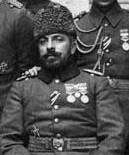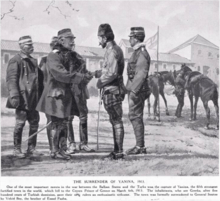Wehib Pasha

Vehib Pasha also known as Wehib Pasha, Vehip Pasha, Mehmed Wehib Pasha, Mehmet Vehip Pasha (modern Turkish: Kaçı Vehip Paşa or Mehmet Vehip (Kaçı), 1877–1940), was a general in the Ottoman Army. He fought in the Balkan Wars and in several theatres of World War I. In his later years, he acted as a military advisor to the Ethiopian army in the Second Italo-Abyssinian War.[1][2][3][4][5]
Biography

Vehib was born in 1877 in Yanya (present day: Ioannina), then part of the Ottoman Empire. Coming from a prominent family of the city his father, Mehmet Emin Efendi, had served as the mayor of the city.[6] He was an Albanian.[7][8][9] His elder brother Esad Pasha defended Gallipoli in 1915, and Kâzım Taşkent was the founder of the Yapı Kredi that is the first nationwide private bank in Turkey. Vehib himself graduated from the Ottoman Imperial School of Military Engineering (Mühendishane-i Berrî-i Hümâyûn) in 1899, and then graduated from the Ottoman War College (Staff College, Mekteb-i Erkân-ı Harbiye-i Şâhâne) as a staff captain and joined the Fourth Army, which was then stationed in Yemen. In 1909, after the 31 March Incident, Vehib was called to Constantinople (Istanbul), where he began to work at the Ministry of War. Shortly afterwards Mahmud Shevket Pasha appointed Vehib as the Commander of the Cadet School (Military high school, Askerî İdadi). He reached the rank of Major.
Balkan wars

During the First Balkan War, Vehib defended the Fortress Yanya with his brother Esad Pasha who was the commander of the Yanya Corps, until February 20, 1913. The Ottoman forces surrendered to the Greeks under Crown Prince Constantine.
After his release as a prisoner of war, Vehib was made a Colonel in the 22nd Infantry Division. He was sent to Hejaz in Arabia.
First World War
The Ottoman Empire entered World War I and Vehib participated in the Gallipoli Campaign, commanding the XV Army Corps, and later the Second Army. His successes led to his being made commander of the Third Army during the Caucasus Campaign. His army held against attacks by the Russians but was defeated in the battle of Erzinjan. In 1918, Vehib's Third Army regained the offensive and took back Trabzon on February 24, Hopa in March, as well as Batumi on March 26. With the Armistice of Mudros, Vehib returned to Constantinople (Istanbul).
War of Independence
Vehib did not participate in the Turkish War of Independence. After his return to Constantinople at the end of World War I, he was prosecuted for misuse of his office and jailed (Bekirağa Bölük). He escaped to Italy. His citizenship was revoked by the new government of Turkey. He spent some time in Italy, Germany, Romania, Greece and Egypt. His dislike of Mustafa Kemal was well known and he never did hide his contempt for the new leader of Turkey who had once fought under his command at Gallipoli. He did not return to Istanbul until 1940.[10]
Abyssinia
Vehib participated in the Second Italo-Abyssinian War where he was known as Wehib Pasha. He served as the Chief-of-Staff to Ras Nasibu, the Ethiopian Commander-in-Chief on the southern front. Vehib designed a strong defensive line for the Ethiopians which was known as the "Hindenburg Wall", in reference to the famous German defensive line of World War I, the Hindenburg Line. However, the Italians broke through these defenses during the Battle of the Ogaden in April 1936. Afterwards, Vehib left Ethiopia and returned to Istanbul.
He died in 1940 and was buried at Karacaahmet Cemetery in Istanbul.
See also
Sources
- ↑ "Eighth Month", Time magazine, May 4, 1936.
- ↑ "Empire's End", Time magazine, May 11, 1936.
- ↑ "Solemn Hours", Time magazine, October 14, 1935.
- ↑ "Water Will Win", Time magazine, October 14, 1935.
- ↑ "Newshawks, Seals", Time magazine, October 14, 1935.
- ↑ Kayallof, Jacques (1973). The battle of Sardarabad. Mouton. p. 14. Retrieved 18 October 2011.
- ↑ Vehib Pasha, the Albanian, was perhaps a tiger; but he was likewise both valiant soldier and grand- seigneur. (Rafael de Nogales, Four Years Beneath the Crescent, C. Scribner's sons, 1926, p. 22.)
- ↑ The Ottoman Albanian Vehib Pasha spoke to the Armenians in the language that any romantic nationalist could comprehend, and his point was clearly to cow his opponents with the depth of Ottoman determination. (Michael A. Reynolds, The Ottoman-Russian Struggle for Eastern Anatolia and the Caucasus, 1908-1918: Identity, Ideology and the Geopolitics of World Order, Volume 1, Princeton University, 2003, p. 424.)
- ↑ Vehib Pasha said I've been the commander of the Caucasian front for one and a half years. I researched Caucasians and learned. You Caucasians love cleanliness like us Albanians. I won't make these dirty Turkish soldiers to enter into the Caucasus, especially with this guise. (Vehip Paşa «Ben bir buçuk yıldır Kafkas cephesi kumandanıyım. Kafkasyalıları tetkik ettim öğrendim. Siz Kafkasyalılar da, biz Arnavutlar gibi temizliği seviyorsunuz. Bu pis Türk neferlerini, hem de bu kılıkta Kafkasya'ya sokamam.» diyor., Naki Keykurun, Azerbaycan İstiklâl Mücadelesinin Hatıraları, Azerbaycan Gençlik Derneği, 1964, p. 64.)
- ↑ Kevin Jackson, Atlas Tarih, No 03, September 2010, pp. 74-76.
External links
- Who is who (Turkish)